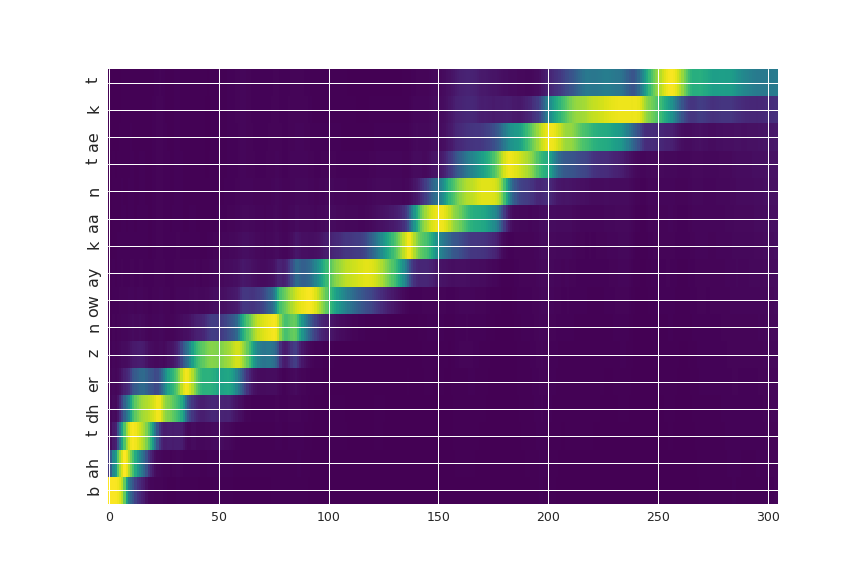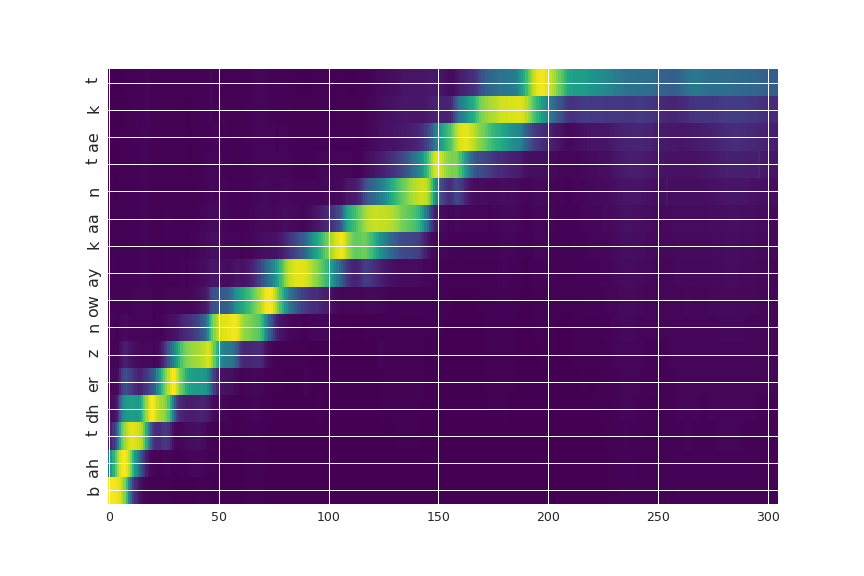PyTorch implementation of the method described in the paper VoiceLoop: Voice Fitting and Synthesis via a Phonological Loop.
VoiceLoop is a neural text-to-speech (TTS) that is able to transform text to speech in voices that are sampled in the wild. Some demo samples can be found here.
Follow the instructions in Setup and then simply execute:
python generate.py --npz data/vctk/numpy_features_valid/p318_212.npz --spkr 13 --checkpoint models/vctk/bestmodel.pthResults will be placed in models/vctk/results. It will generate 2 samples:
- The generated sample will be saved with the gen_10.wav extension.
- Its ground-truth (test) sample is also generated and is saved with the orig.wav extension.
You can also generate the same text but with a different speaker, specifically:
python generate.py --npz data/vctk/numpy_features_valid/p318_212.npz --spkr 18 --checkpoint models/vctk/bestmodel.pthWhich will generate the following sample.
Here is the corresponding attention plot:
Legend: X-axis is output time (acoustic samples) Y-axis is input (text/phonemes). Left figure is speaker 10, right is speaker 14.
Finally, free text is also supported:
python generate.py --text "hello world" --spkr 1 --checkpoint models/vctk/bestmodel.pthRequirements: Linux/OSX, Python2.7 and PyTorch 0.1.12. Generation requires installing phonemizer, follow the setup instructions there. The current version of the code requires CUDA support for training. Generation can be done on the CPU.
git clone https://github.com/facebookresearch/loop.git
cd loop
pip install -r scripts/requirements.txtThe data used to train the models in the paper can be downloaded via:
bash scripts/download_data.shThe script downloads and preprocesses a subset of VCTK. This subset contains speakers with american accent.
The dataset was preprocessed using Merlin - from each audio clip we extracted vocoder features using the WORLD vocoder. After downloading, the dataset will be located under subfolder data as follows:
loop
├── data
└── vctk
├── norm_info
│ ├── norm.dat
├── numpy_feautres
│ ├── p294_001.npz
│ ├── p294_002.npz
│ └── ...
└── numpy_features_valid
The preprocess pipeline can be executed using the following script by Kyle Kastner: https://gist.github.com/kastnerkyle/cc0ac48d34860c5bb3f9112f4d9a0300.
Pretrainde models can be downloaded via:
bash scripts/download_models.shAfter downloading, the models will be located under subfolder models as follows:
loop
├── data
├── models
├── blizzard
├── vctk
│ ├── args.pth
│ └── bestmodel.pth
└── vctk_alt
Update 10/25/2017: Single speaker model available in models/blizzard/
Finally, speech generation requires SPTK3.9 and WORLD vocoder as done in Merlin. To download the executables:
bash scripts/download_tools.shWhich results the following sub directories:
loop
├── data
├── models
├── tools
├── SPTK-3.9
└── WORLD
Single speaker model is trained on blizzard 2011. Data should be downloaded and prepared as described above. Once the data is ready, run:
python train.py --noise 1 --expName blizzard_init --seq-len 1600 --max-seq-len 1600 --data data/blizzard --nspk 1 --lr 1e-5 --epochs 10Then, continue training the model with :
python train.py --noise 1 --expName blizzard --seq-len 1600 --max-seq-len 1600 --data data/blizzard --nspk 1 --lr 1e-4 --checkpoint checkpoints/blizzard_init/bestmodel.pth --epochs 90Training a new model on vctk, first train the model using noise level of 4 and input sequence length of 100:
python train.py --expName vctk --data data/vctk --noise 4 --seq-len 100 --epochs 90Then, continue training the model using noise level of 2, on full sequences:
python train.py --expName vctk_noise_2 --data data/vctk --checkpoint checkpoints/vctk/bestmodel.pth --noise 2 --seq-len 1000 --epochs 90If you find this code useful in your research then please cite:
@article{taigman2017voice,
title = {VoiceLoop: Voice Fitting and Synthesis via a Phonological Loop},
author = {Taigman, Yaniv and Wolf, Lior and Polyak, Adam and Nachmani, Eliya},
journal = {ArXiv e-prints},
archivePrefix = "arXiv",
eprinttype = {arxiv},
eprint = {1705.03122},
primaryClass = "cs.CL",
year = {2017}
month = October,
}
Loop has a CC-BY-NC license.


